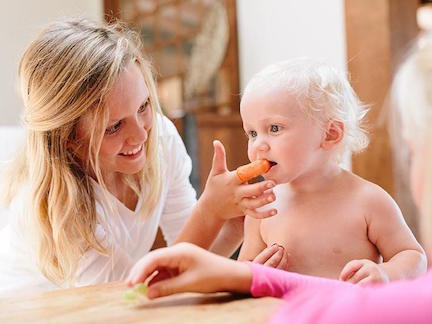|
Baby and Toddler Tooth Care Tips
Baby teeth can start to come in any time between 4 months and 12 months, which means your child could be at a wide range of developmental stages when teeth appear. Fortunately, the recommendations for how to take care of your baby’s teeth are easy to follow for any age, and there are a lot of ways to make tooth care a fun and interactive experience. Here’s a look at how to implement a tooth brushing routine for your baby.
Getting Started
One thing that surprises most parents is you can actually start using a tooth brush for babies as early a few weeks old. However, most parents tend to wait until baby’s first tooth has erupted or until they start eating solids, whichever is earlier, and that’s certainly early enough to help your baby adjust. There are a couple reasons starting a teeth cleaning routine early is a good idea. First, the earlier you start, the easier it is for babies to get comfortable with having a toothbrush in their mouth. Second, it helps to break up and remove any bacteria that might be growing on their gums.
Brushies was designed by two doctor moms who wanted a safe and easy option for brushing early and making the process fun. There are four different character options to choose from and kids love the easy-to-hold shape that parents can wear on their finger.
While starting early is the best way to get babies comfortable with brushing, there are other activities you can implement to get your kids excited about making it a part of their morning and evening routines. Here are a couple ideas to try:
Helpful Healthy Habits
Taking care of your child’s teeth should be a fun, low-stress activity for everyone involved. So even if your little one doesn’t adapt right away to the process, it doesn’t make you a failure. As you’re figuring out what works for your family, try to implement these habits to help make the process easier and healthier for everyone.
Go light on toothpaste. Until the age of three, kids only need a tiny rice-sized smear of toothpaste on their brush. After 3, when they can more easily spit it out, they can start using a pea-sized amount. The American Academy of Pediatrics (AAP) recently updated their recommendation to say that kids and babies should use fluoride-containing toothpaste as soon as their first tooth erupts, which is part of the reason there should only be such a small amount of the brush. There are non-fluoride options available for kids as well.
Build a routine. Something as simple as brushing teeth twice a day can be a lot to tackle with a baby or toddler. Establishing a routine so you expect it to be one of the first things you do together in the morning and one of the last things before bed time can help set expectations.
Sub water for milk at bedtime. Many kids have an easier time falling asleep if they’re nursing a bottle — and that sleep is precious. It can be tough to get kids to break the habit of falling asleep with a bottle, but it’s important to try because this can lead to tooth decay. If you’re not able to remove the bottle completely, try filling the bottle with water instead of milk by slowly diluting milk with water over time.
Visit the dentist around baby’s first birthday. This gives your dentist the chance to make sure everything is developing as expected and gets baby comfortable with the process.
Remember, as long as you’re interacting with your child in a positive way to encourage brushing and tooth care, you’re already on the right path. Try different things, have fun, and make brushing a part of your child’s regular routine.
|
